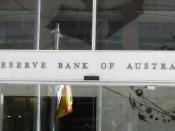IntroductionExchange Settlement Accounts (ESA) are accounts financial institutions held with the Reserve Bank in order to settle their obligations of purchasing or selling securities to each other and to the RBA. Banks must maintain their Exchange Settlement funds on credit balance at all times with the RBA. The usual aggregate amount of funds in ESAs over the last few years is $700 millions to $800 millions.
Forms of RBA's open market operations(i)Commonwealth Government Securities (CGS)In order to control the target cash rate, RBA can purchase or sell short-dated CGSs outright. By purchasing a security from a bank outright, RBA credits funds into Bank's ESAs. This transaction is known as RBA injecting or providing liquidity to banks. On the other hand, if RBA sells a security to a bank outright, the ES funds will be withdrawn from the bank's ESA. The process is known as withdrawing or reducing liquidity out of financial system.
(ii)Repurchase agreementsInstead of conducting transactions outright, RBA can undertake transactions under repurchase agreements. That means RBA can purchase or sell securities and simultaneously enter into an agreement with banks to reverse the transactions at the later determined date and with an agreed price.
One of the Reserve Bank's main objectives is to implement monetary policy by using market operations and influence its set cash rate. It has a great flexibility in its policy settings in order to ensure that its cash rate does not materially deviate from a determined level and react to ever-changing financial markets. As can be seen in Graph 1, most of transactions during the last 10 years were done in repurchase agreements, some in foreign exchange agreements and a very small portion in Commonwealth Securities.
By using those instruments, Bank conducts its sales or purchases in accordance to demands for cash by market participants. As there are needs for liquidity in the market, Bank purchases securities or enters into repurchase agreements. This results in an increase in funds in exchange settlement accounts. Conversely, as there are surplus funds in the market, Bank sells securities to reduce balance in exchange settlement funds. In doing these exercises, Bank's aim is to maintain demand and supply of funds in equilibrium.
Problems in Australian financial markets in recent monthsProblems that emerged in the Australian money market in the latter months in 2007 are caused by the sub-prime loan market in the US. Since August 2007, there is a significantly sharp increase in demand for ES funds, hence, placing a huge pressure on a short term money markets. Investment vehicles such as residential mortgage lenders, hedge funds used to use short term asset-backed commercial papers to fund their long term investments or to finance sub-prime residential mortgages (similar to Low Doc Loan in Australia). In order to ask for more liquidity as short term funding is dried up, those financial vehicles then turned to their sponsoring banks which became very cautious and unwilling to commit.
In addition, primary markets for securities related to mortgages are virtually shut down.
Investors are running away from new mortgage-backed securities issues. As a consequence, banks are forced to retain those loans they originated, in turn, creating a pressure for demanding more cash from other sources. Because of this uncertainty in the credit markets, banks get unwillingly lending to each other. Hence, again, cash is highly sought after from all market participants.
In order to respond to liquidity problems, the Reserve Bank has stepped in and acted as a rescuer in number of ways.
(i)Injecting a significant amount of cash into financial market. At one point, Exchange Settlement funds increased to $5.5 billion compared to a normal level of $750m.
(ii)Increasing its role in conducting more repurchase agreements, particularly in bank bills and certificates of deposits. At the same time, Bank reduces its holdings on government securities. As a result, Bank's holdings of domestic bank bills and CDs increased two-fold.
(iii)Increasing maturities of repos in order to tackle a substantial rise in demand for long term funding. As a result, maturities extend from a normal level of 20 days to over 50 days and in some cases, go beyond 3 months.
(iv)Reducing its exposures in foreign exchange swaps to cater more for domestic needs.
(v)Broadening the range of securities Bank can use for collateral, namely, high quality long term securities, asset-backed commercial papers, and residential mortgage-backed securities.
ConclusionThe Reserve Bank influences the Exchange Settlement Accounts held with financial institutions to inject or withdraw liquidity. Its tool is mainly on repurchase agreements, taking collaterals over a range of securities with various maturities. Over the recent months, the Bank has performed extremely well in monitoring the provision for liquidity and as a result, avoiding market turmoil.
ReferencesRBA (2007), "Central Bank Market Operations", Bulletin, September, pp. 19-26 (excluding pp. 23-24)RBA (2007), "Open Market Operations and Domestic Securities", Bulletin, December, pp. 25-31RBA website, 2007, Open Market Operations, RBA, Australia. Viewed at 20 April 2008 http://www.rba.gov.au/DomesticMarketOperations/open_market_operations.html








